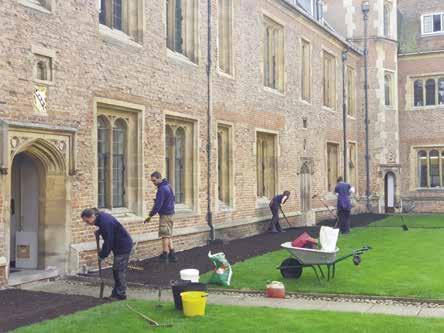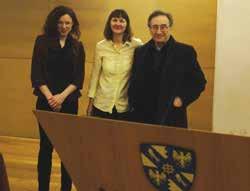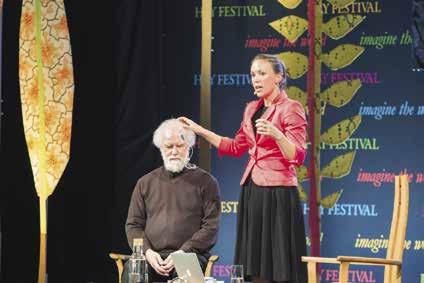
15 minute read
The unlikely hero of Everest: the other side of George Mallory: R Hyam
THE UNLIKELY HERO OF EVEREST:
THE OTHER SIDE OF GEORGE MALLORY
Advertisement
Remembered as a charismatic undergraduate at Magdalene, with many diverse interests, Captain of the Boat Club, a young man of captivating physical beauty, which made him a Bloomsbury idol, a nude model, devotee of naked wild swimming; mildly rebellious and vaguely imbued with fashionable homoeroticism, but later a happily married family man; of strong social conscience and left-wing leanings, for many years an unconventional but inspirational schoolmaster, teaching history and English literature, becoming a progressive educational theorist, a man with many friends and admirers among the London literary elite, and himself a gifted writer, aspiring poet, and accomplished scholarly author, setting everything down in elegant penmanship; impractical, perhaps, but something of a polymath, a ‘Renaissance man’ indeed: and now, in 1924, aged 38, poised on the brink of a promising career as a Cambridge academic, likely to become an influential and much-loved university character…
So where did it all go wrong? The short answer is a fatal fall a few hundred feet from the top of the highest and most challenging mountain in the world, EverestChomolungma, Goddess-Mother of the Earth, on 8 June 1924.
Because George Mallory, for all his other attributes, was above all, a mountaineer, who came to an untimely and mysterious end – a man celebrated ever since as a romantic symbol of human dedication, determination, courage, vision, and endurance. And so there have been numerous books and speculations innumerable about Mallory in the last 94 years. This article can make no claim to originality: almost anything one can say about even the lesser-known side of his life and personality has already been said by someone during the last 94 years. But details can be added from the College Archives.
Like everyone else seeing Mallory for the first time, A C Benson (then Junior Fellow of the College) was struck by his exceptional good looks. Benson was to figure in Mallory’s life from his early days in Magdalene during the Michaelmas Term of 1905. Mallory read for the Historical Tripos and Benson was his supervisor (‘one of my History boys; he is also a great Alpine climber’). Benson concentrated on technique for the compulsory English Essay, at which his pupil soon excelled. They became close friends, and remained so for the rest of Mallory’s life. Benson visited Mallory in his rooms ‘at the corner of the court’, overlooking the street. At the end of the Michaelmas Term 1906 Benson invited him to stay for a week at his Cambridgeshire retreat, Hinton Hall in the village of Haddenham. This was followed by another particularly enjoyable week of rural rides in June 1907, and then by a few days in July at the Benson family home, ‘Tremans’ in Sussex: Benson was pleased how easily he fitted in. He introduced him to his circle of Cambridge
notables. For his part, Mallory took his friend Rupert Brooke to meet Benson; and when his supervisor was suffering from depression between 1907 and 1909, he was the only junior member confident and close enough to try regularly to help, sometimes inviting Benson to tea, or suggesting a bicycle ride together, or joining him in the evening for a game of cards, or simply a chat. Benson gratefully recorded that ‘the charming Mallory’ had been ‘endlessly good to me’ during his depression, ‘always ready to talk or walk or fall in with everything’.
Mallory led an extremely active student life, taking up rowing, joining the Fabian Society and the Women’s Suffrage Association, even acting in the Marlowe Society’s inaugural production, Dr Faustus (he played the part of the Pope), and morris dancing in Comus. He was secretary of Magdalene Boat Club in 1907 and Captain in 1908 (‘a phenomenally successful year’). He was secretary of Benson’s Kingsley Club (a discussion group for the brightest Magdalene men), at which he read two papers himself, one on St Francis, (‘very thoughtful & enthusiastic, & in some places with a real beauty of style’), the other on James Boswell (‘long and interesting’). His third secretaryship arose out of his keen interest in the College’s urban mission, the Magdalene Lads’ Club in Camberwell, organising a Whitsunday outing in Cambridge for the boys (a cricket match and a trip by river launch to Baits Bite Lock). This was in his fourth year, after he had completed the Historical Tripos with a Second, at the time an undivided class; and with Benson financially supporting him. As a graduate, Mallory was living in a College hostel, Pythagoras House, as it was then known (but no longer), 26 Northampton Street, where a famous photograph of him was taken. Looking studious and sophisticated, you would never guess he had only recently narrowly escaped being arrested for ‘indecent exposure’ on Magdalene Bridge after a bibulous nocturnal punting spree with his rowing chums.
It was Benson who inspired Mallory’s interest in Boswell, Dr Johnson’s biographer, and writing about him was the excuse for the fourth year. Benson then encouraged him to turn an essay into a book. Boswell the biographer (1912)was the result, a substantial, comprehensive treatment, and its status as the first modern study of Boswell has led to several reprints. It was published during Mallory’s eleven years as a schoolmaster at Charterhouse, 1910 to 1921. In the preface, Mallory
thanked three friends: A C Benson, G L Strachey, and E H Marsh. He could not have had three better literary mentors. Benson had taught him how to write, and his own biographical writings were among his best and most enduring; Giles Lytton Strachey was acclaimed a few years later for his Eminent Victorians; and Eddie Marsh, private secretary to Winston Churchill as a Liberal government minister, 1905–1915, was literary editor to a number of leading authors, and literary executor to Rupert Brooke.

Pastel drawing by Simon Bussy (c 1909) Nude study (oil) by Duncan Grant (1909)
By this time, Mallory had abandoned his earlier intention of being ordained like his father; Benson did not discourage ordination, but Mallory’s faith perhaps was weakened by his mentor’s rationalism. He began to wonder whether Boswell might lead to a lectureship in a provincial university. His literary ambitions were stimulated by finding himself right in the midst of a group of Bloomsbury friends, mostly Cambridge-educated: not just Rupert Brooke, Eddie Marsh, and Lytton Strachey, but Lytton’s brother James, Maynard and Geoffrey Keynes, the climber Geoffrey Winthrop Young, and the painter Duncan Grant. Mallory was an enthusiastic nude model for Grant (‘I’m profoundly interested in the nude me’). This group were united by their left-wing and homoerotic interests, youthful rebels, believers above all in the value and importance of friendship and aesthetic experience, unafraid of expressing their emotions, both verbally and physically. Mallory was strongly attracted to James Strachey (later a leading psychoanalyst), and insisted on trying out anal intercourse with him; afterwards, this was not something he wanted to repeat, but it led to his being pursued by James’s brother. Lytton’s rhapsodic description of Mallory has been frequently quoted:
Mon dieu! George Mallory! He’s six foot high, with the body of an athlete by Praxiteles, and a face – oh incredible – the mystery of Botticelli, the refinement of a Chinese print, the youth and piquancy of an unimaginable English boy…. The sheer beauty of it all is what transports me.
In 2015, 34 letters written by Mallory to Lytton Strachey from 1909 onwards were sold at auction by Bonham’s for £18,750. They were said to reveal his ‘flirtatious side’. One of the letters written at about the time of Mallory’s unexpected marriage to Ruth Turner in 1914 sought to reassure Lytton of his continuing friendship: ‘I am still part of that [homosexualist] persuasion’.
Benson noted in his diary that Mallory the schoolmaster had a number of ‘emotional affairs’ with the boys, and ‘mostly entertains boys’ even after his marriage. Those whom Mallory found rewarding included Alan Goodfellow (‘a delightful boy… one of the nicest of people’), Raymond Rodakowski (‘he makes me feel better’), and Raymond’s friend Robert Graves. Mallory took each of these three boys – and several others at different times – on climbing holidays in Snowdonia. These expeditions were some of the most idyllic aesthetic experiences of his life. Robert Graves was the most appreciative. He became the most famous of Mallory’s pupils, a poet and novelist, author of a classic autobiography, Goodbye to all that (1929), in which he writes about Mallory’s influence on him. Having been bullied, Graves was grateful for his protective tutelage, and for introducing him not only to modern literature but to the joys of climbing. A man of such originality and sensibility was, he decided, ‘wasted at Charterhouse’. When Mallory died, Graves told Ruth that ‘George was my first real friend and he always remained so… I did love him’.

The young Robert Graves Ruth (Turner) Mallory
Ruth proved to be an ideal partner for Mallory. Not only did Ruth completely understand Mallory’s delight in nudism, as her father was a committed family nudist, but she was easily co-opted into her husband’s friendship circle with special boys, his ‘most select number of pals’. He was pleased that Ruth became fond of them too: ‘you are good at loving my friends’. When he went off to fight in France in the middle of 1916, Ruth carefully maintained these relationships, not least by supporting Robert Graves in his unconventional friendship with a much younger boy, Peter Johnstone (‘Dick’ in Goodbye to all that). In October 1916 she arranged for them to stay together with her while Robert was on leave, and Johnstone still at school. Mallory was pleased, and of course wished he could have joined them.
Mallory was a gunner-officer with the Royal Artillery, and had a comparatively easy war, though he wanted ‘to fight in this cause’, and ‘would much rather be in the thick of it’. He had not ‘the slightest interest in military affairs excepting in so far as they bear upon the end of the war’. He was able to keep up his reading, particularly of ‘the vast and wonderful French literature’, and to reflect more deeply about education. Ruth bombarded him with long letters and regular chocolate cakes, together with parcels of anything he asked for, such as potatoes and carrots, Turkish cigarettes, gin, soup tablets, and a loofah. He yearned for a decent swim in a green meadow, to feel ‘the ripple of a delicious stream over my limbs’. In September 1918, with the end of the war in sight, he had to organise a sports afternoon for soldiers stationed near the Channel coast. He arranged for the event to kick off with the men standing to attention. Then, ‘at the blast of a whistle [they] began to undress; when nude they ran to the sea, rolled in it, & came back…. Altogether the men enjoyed themselves, & so did I’.
After the war he returned to Charterhouse, until in January 1921 his life took a dramatic turn. He was invited to join the expedition to Mt Everest, planned for later in the year. He had always climbed regularly since he was a Winchester schoolboy, and he had acquired a reputation as the foremost Alpinist of his generation, admired for his resilience and agility. With Ruth and a growing family to consider, he was always in two minds about going to Everest, but Ruth was supportive, and the three expeditions presented ever-growing opportunities. He and Ruth relieved his repeated absences, as they had during the war, with a full and affectionate correspondence. Particular highlights of this were his descriptions of the great mountain, how he experienced ‘the strange elation of seeing Everest for the first time…. It was a prodigious white fang excrescent from the jaw of the world’. In another remarkable letter he laid out a plan to bring a young Nepalese Sherpa, aged about eighteen, back to England with him as a houseboy or personal servant. Nyima had accompanied him as a porter on several exploratory searches for the best route to the summit. He was attracted by his ‘boyish outlook on life’, and described him to Ruth as ‘one of the most helpful people I have ever seen… a ready, willing, unselfish & extraordinarily happy & smiling character’; he had ‘a quality
of devotion’, and would be faithful as well as intelligent and quick. He explained in detail to Ruth how Nyima might fit in and work with their existing servants. Although this fascinating scheme reflected the middle-class needs and attitudes of the time, it also shows his continuing affinity with promising boys and young men, and his desire to help them. However, uncertain of Ruth’s reaction, and whether she would be inclined to take the inevitable risks, he decided against it. Getting her to pass on exotic postage stamps he occasionally bought from street-vendors was much easier: ‘If you know of any small boy of our acquaintance, Bobby, or John, or Franz, will you send them on to them’. (Franz Knefel, or Nevel, was a Czech refugee of eleven when Ruth invited him to stay with them for holidays: this he did for several years from 1922, idolising Mallory.)

1922 Everest expedition team; Mallory, bottom row, far left
The trials and frustrations of the expeditions obviously figured largely in their correspondence, but never exclusively. One special interest they shared was in botany and gardening: his botanising in the Himalaya, her gardening at home. He enjoyed the beauty of semi-tropical Sikkim, and its opportunities for wild swimming (‘bathing properly’), but he didn’t care for the bleak highaltitude desert-plateau of ‘treeless Tibet’. There were however some rewarding valleys, and during the 1922 expedition he discovered on a hillside valley among the rhododendrons, ‘a fine yellow polyanthus primula & it was so beautiful I nearly fell down and wept with the joy of it’. Rather like a clustered snowdrop, it was ‘a ravishing flower…. I’ve never seen anything that so knocked me silly’. The expeditions regularly collected seedlings, and Mallory desperately hoped they could get this one home safely; perhaps it would be named after him, ‘for I am certain it’s new’.
He and Ruth always wrote about what they had been reading. Apart from card games, evenings in a tiny tent on the mountain were usually spent relaxing with a book. As in France, his pocket-volume of four Shakespeare plays – Lear, Hamlet, Romeo and Juliet, & Othello – always accompanied him. He enjoyed recitations from The Spirit of Man (1916), a new anthology of poetry edited by Robert Bridges. His one disappointment with Andrew Irvine, chosen as his final climbing companion, was that he was ‘poetry shy’ and would not join in.

Irvine and Mallory (1924)
*
Mallory had resigned from Charterhouse in order to join the 1921 expedition. The 1922 expedition followed on so closely, it was only after it was over that alternative employment needed to be found. Not immediately, because he made more money than as a schoolmaster by lecture tours all over Britain and in the USA and Canada. Almost certainly, he wanted to make writing his career. ‘I wish I were a poet’, he once told Ruth. Perhaps he could make a living as a journalist? In that way, he could have promoted the causes dear to him, progressive education, iconoclastic modern art, the cosmopolitan ideals of the League of Nations (‘I think and feel passionately about international politics’). For several years he had wrestled with an unpublished manuscript, ‘The Book of Geoffrey’, cast in the form of a novel, but in fact a polemic about the deficiencies of the public school system. He had however published a pamphlet on War work for boys and girls (1915), emphasising the need for ‘clear thought’, one of his favourite pedagogic principles; he particularly hoped Benson would approve of it. There were also articles on theories of education for the Daily Telegraph, and on ‘the art of climbing’ for the Alpine Journal, the Climbers’ Club Journal and other periodicals. He had written a sparkling and evocative official report on the 1922
expedition. Had he lived to tell the tale, he might have written a brilliant and exciting masterpiece about the conquest of Everest.
But in 1923 he still needed a job. He applied for the post of Secretary and Lecturer for the Cambridge Extra-Mural Studies Board, linked to the Workers’ Educational Association. Benson was once more part of the story. It was the Master of Magdalene’s reference which was crucial in securing Mallory’s appointment from October 1923. Benson was one of the first of his friends to be invited to dinner in George and Ruth’s new home, Herschel House, a large 1880s property, just off Grange Road, leased from Clare College (the house was demolished in 1966 to make way for the new Clare Hall). Benson was thrilled by the new appointment: it was good for the College, and a post ‘which would have given him full scope for his energies, and afforded him exactly the opportunities he most desired’. Mallory was elected as a Member of High Table.
How badly Benson was affected by Mallory’s death only a few months later we cannot be sure, but he was ‘not well enough’ to attend the College Memorial Service on 24 June 1924; he was apparently laid up with ‘bad legs’, but perhaps he did not trust himself not to break down. So he did not deliver the address he had written: instead it was read out by the President, A S Ramsey. There is certainly anguish in Benson’s diary entry about the tragic news from Everest: ‘After all, it is just a feat’. He did however attend the national Memorial Service in St Paul’s Cathedral in the autumn: ‘I was somehow more impressed than moved – it all seemed so unlike George to be celebrated – unlike his unaffected modesty’.
As a young man, Benson himself had enjoyed climbing, until he sustained an injury. There was so much they had in common: a love of beauty, art, and literature, poetry especially, a commitment to the importance of friendship, a rapport with young people, a scepticism about public school education, a similarity of outlook, of preferences, of opinions, a refusal to accept anything unthinkingly, least of all religious dogma, or social convention. Benson had essentially taught Mallory how to think more clearly, and to write well. In all these ways, there was so much Mallory had imbibed from his close friendship with his charismatic mentor. In so many ways, therefore, Benson is the key to understanding the other side of the hero of Everest. R H










